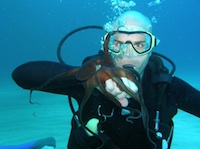Google Glass in Science Class
 Today I had the incredible opportunity to go pick up my school’s new pair of Google Glass. As part of the Glass Explorer Program, we’ll have an early edition of the glasses to try out before the glasses go on sale to the public later this year. Being in the Bay Area, my colleague Jenny and I took advantage of the option to trek down to Google’s San Francisco offices where we were able to pick up the glasses with a one-on-one tutorial and set-up session with a Glass expert.
Today I had the incredible opportunity to go pick up my school’s new pair of Google Glass. As part of the Glass Explorer Program, we’ll have an early edition of the glasses to try out before the glasses go on sale to the public later this year. Being in the Bay Area, my colleague Jenny and I took advantage of the option to trek down to Google’s San Francisco offices where we were able to pick up the glasses with a one-on-one tutorial and set-up session with a Glass expert.
 For those of you who aren’t familiar with the technology, the glasses (officially called “Google Glass”) consist of a small screen and camera that are contained within a pair of lens-free glass frames. The screen sits about one inch away from your eye, just above your line of sight. Thanks to the screen, a set of sensors, a camera, GPS sensor, and a data connection, Google Glass is able to take pictures and video, respond to user voice commands, and display information related to the user’s location. For a basic example, to take a picture, simply look up to trigger the glasses then say “Ok glass, take a picture.” The device captures the user’s field of view in a picture which is then uploaded to the cloud. Things get more interesting when using glass apps – imagine sitting in a cafe in Paris, looking at a cafe menu while wearing Google Glass. Without hesitation, the menu item you’re looking at appears translated into English on the screen of the glasses.
For those of you who aren’t familiar with the technology, the glasses (officially called “Google Glass”) consist of a small screen and camera that are contained within a pair of lens-free glass frames. The screen sits about one inch away from your eye, just above your line of sight. Thanks to the screen, a set of sensors, a camera, GPS sensor, and a data connection, Google Glass is able to take pictures and video, respond to user voice commands, and display information related to the user’s location. For a basic example, to take a picture, simply look up to trigger the glasses then say “Ok glass, take a picture.” The device captures the user’s field of view in a picture which is then uploaded to the cloud. Things get more interesting when using glass apps – imagine sitting in a cafe in Paris, looking at a cafe menu while wearing Google Glass. Without hesitation, the menu item you’re looking at appears translated into English on the screen of the glasses.
 My school decided to join the Google Glass Explorer Program to explore the technology’s potential to transform the classroom by teaching and engaging students in new ways. From assessing student learning to creating video guides and field trips, the plan is for any staff member to be able to write a proposal explaining how they’ll use the glasses in their classroom over the course of a week. Names will be drawn out of a hat, with the lucky educators being expected to document their work so that it can be shared with other teachers. Below are some of the ways I hope to try using the technology in my science classroom.
My school decided to join the Google Glass Explorer Program to explore the technology’s potential to transform the classroom by teaching and engaging students in new ways. From assessing student learning to creating video guides and field trips, the plan is for any staff member to be able to write a proposal explaining how they’ll use the glasses in their classroom over the course of a week. Names will be drawn out of a hat, with the lucky educators being expected to document their work so that it can be shared with other teachers. Below are some of the ways I hope to try using the technology in my science classroom.
My Plan for Google Glass
1) With my school’s ongoing focus on teaching 21st century skills, conversations repeatedly come up on how to assess students on skills such as creativity and problem solving. Using the video feature of Google Glass, I plan to record students working in groups so as to capture their work habits and the growth of their knowledge throughout a unit. These videos will become part of the students’ portfolios, allow for classroom learning moments to become part of their student led conferences.
 2) Students wearing the glasses will create video walk throughs of their cell projects. These first-hand videos will capture their work and their explanations, documenting their learning in a powerful new way.
2) Students wearing the glasses will create video walk throughs of their cell projects. These first-hand videos will capture their work and their explanations, documenting their learning in a powerful new way.
3) Wear the glasses at the upcoming NSTA convention in Boston, MA, capturing images and videos that will allow me to share my discoveries and learnings with colleagues once I’m back at school.
4) Create video field trips or “trip previews” for my students. I envision heading to the science museum in advance of my class field trip, narrating and recording teacher point-of-view videos for key exhibits. By uploading these videos to student iPads, I can help ensure key science concepts are conveyed to students while still allowing them to explore the museum in small groups at their own pace.
